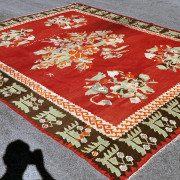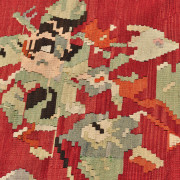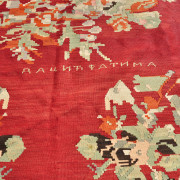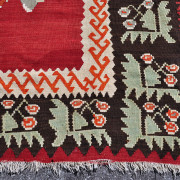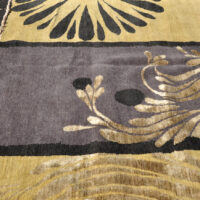Description
Large signed Yugoslavian kilim with stylized flowers on a red field. Good condition with minor wear on ends and moderate color abrash (color variegation due to different dying batches). This estate textile came with its original purchase tag: it was last sold in a New York rug gallery in 1989. Evidently a vintage piece in 1989, it was probably woven in the 1970s in Yugoslavia.
The kilim is signed, rather prominently, by the weaver. The Cyrillic lettering on the rug reads Dacić Fatima. (Heather, a long time resident of Montenegro, provided translation help.) The surname, written first, is Slavic; the weaver’s first name, Fatima, is of Muslim origin. Probably from the Bosnian region of Yugoslavia, which was long an Ottoman territory. The mysterious letter ‘K’ (which is similar in Cyrillic and Latin alphabets) is also woven into the kilim. Perhaps a gift or dowry with K as the recipient?
Flat-weave kelims (another common spelling) are the quintessential nomadic tribal textiles because they can easily be folded, packed, and moved. For a nomad a large pile rug is inconvenient to drag around. Kilims provide spectacular decorative pieces for celebrations, weddings, and gatherings. They can be used on the floor or suspended as a tapestry.
Much more supple than a pile rug, a simple mesh pad is recommended to keep a kilim in place on a wood or tile floor. If have a particular use in mind and are not familiar with kilims or flatweave textiles — feel free to contact me.
Exact size is 11 ft. 3 in. by 9 ft. Shipping is $43 within U.S.
Please email me with questions. Thank you.
Historical and political footnote:
Unfortunately, Yugoslavia, which had been a reasonably successful multi-religious nation, disintegrated in a violent civil war based on religious and nationalistic schisms in the 1990s. The disintegration and collapse was partly engineered by outside ‘forces’ with their own agenda. (My own tour of Zagreb, Dubrovnik, Mostar, and Sarajevo coincided with the NATO bombing of the Serbian region in May, 1999, and I was unable to visit Belgrade. Diana Johnstone, the author of a book on the breakup of Yugoslavia, offers a thoughtful perspective not typically encountered in Western mass media.)
(Ki0054 N22)


